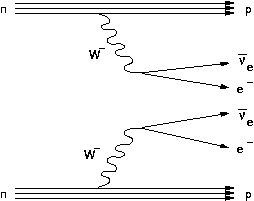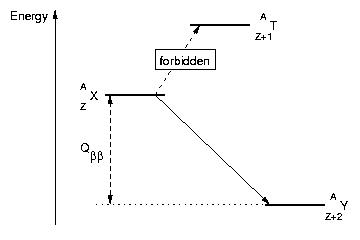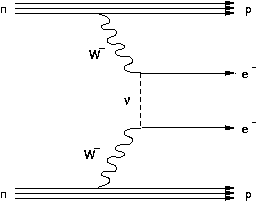
Physics goals - The Double Beta Decay
|
|
|
|
|
|
|
The two neutrino double beta decay
In 1935, Maria Goeppert-Mayer predicted the existence of the two neutrino double beta decay process (DBD).
This decay mode is theoretically allowed in the SM framework; it is labelled ββ2ν. This process (the β-β- mode) consists in the simultaneous transmutation of two neutrons into protons inside a nucleus thanks to β decay like processes (figure 10).
Note: β+β+ decay exists too...

|
|
|

|
The double beta decay process can be observed in a few isotopes for which all other decay channels are forbidden for energetic reasons (figure 11).

|
Calculations predict that this process is very rare, with mean lifetimes of the order of 1018-24 years depending of the emitter isotope. The half life time is given by the following formula:
- Where:
- a2ν ~ 2 10-22 y-1 is a dimensional factor
- F2ν is a known phase space factor proportionnal to
Qββ11
- M2ν is the nuclear matrix element (n.m.e.).
Only a few ββ emitting isotopes are good candidates for experimental studies. They are shown in table 4. The ββ2ν process have been experimentally observed for most of them.
| Isotope | Qββ (MeV) | Isotopic abundance (%) |
F2ν | Half life T1/2,2ν (y) exp. |
|---|---|---|---|---|
| 48Ca | 4.271 | 0.0035 | ~ 140 103 | ~ 4.0 1019 |
| 76Ge | 2.039 | 7.8 | ~ 0.5 103 | ~ 1.4 1021 |
| 82Se | 2.995 | 9.2 | ~ 15 103 | ~ 0.9 1020 |
| 96Zr | 3.350 | 2.8 | ~ 70 103 | ~ 2.1 1019 |
| 100Mo | 3.034 | 9.6 | ~ 33 103 | ~ 8.0 1018 |
| 116Cd | 2.802 | 7.5 | ~ 28 103 | ~ 3.3 1019 |
| 128Te | 0.868 | 31.7 | ~ 2.8 | ~ 2.5 1024 |
| 130Te | 2.533 | 34.5 | ~ 16 103 | ~ 0.9 1021 |
| 136Xe | 2.479 | 8.9 | ~ 16 103 | not observed yet |
| 150Nd | 3.367 | 5.6 | ~ 400 103 | ~ 7.0 1018 |
Suppose we use 1 kg of 100Mo (10 moles), how many
ββ2ν decays do we get in one year?
Answer:
where NA is the Avogadro constant.
Assuming that our 100Mo sample is contaminated by some natural 214Bi radioactivity at the level of 1 Bq/kg, we get about 3 107 beta decays due to natural 214Bi radioactivity for the same period: this is about two orders of magnitude higher than the expected number of ββ2ν events. That means that natural radioactivity is likely to act as a background provider, preventing an efficient direct observation of the very rare double beta process.
The neutrinoless double beta decay
In 1939, Wolfgang Furry proposed that a double beta decay without emission of neutrino (labelled ββ0ν) could occur in ββ emitting nuclei if new physics exist beyond the standard model. In ββ0ν decay, two neutrons in a nucleus are simultaneously changed in protons emitting two electrons but without emitting any anti-neutrinos (figure 12).

|
|
|
The existence of such a process violates the lepton number conservation rule, thus it is forbidden by the SM. Nevertheless, ββ0ν decay could exist if (figure 13):
- (anti-)neutrinos have a non zero mass,
- neutrinos are a Majorana particles, i.e. neutrinos and anti-neutrinos are the same particle.
 |
Note: other mechanisms have also been invented to explain such a process.
Neutrinoless double beta decay is the only known process that enables to test experimentally the Majorana nature of neutrino together with its absolute mass scale. That makes this topics very attractive.
The half life time is given by the following formula:
- Where:
- a0ν ~ 5 10-17 y-1 is a dimensional factor
- F0ν is a known phase space factor proportionnal to
Qββ5
- M0ν is the nuclear matrix element (n.m.e.).
- η = <mν>/me with <mν> being the effective mass of the exchanged neutrino and me the mass of the electron (0.511 MeV/c2).
From the formula above, we see that the observation of the ββ0ν process enables the estimation of the (Majorana) neutrino mass scale <mν>. Here again the calculation of the nuclear matrix element is an important source of uncertainty.
Contents
|
Last update: 30-03-2004

